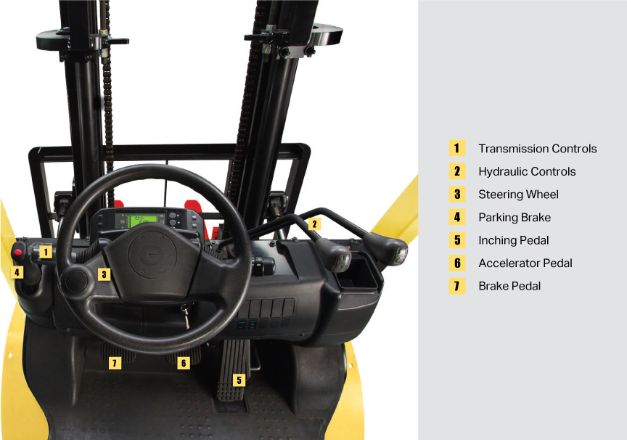Common Forklift Controls Overview
Forklift controls may vary depending on the type of unit.
Before operating a forklift it is imperative operators familiarise themselves with the controls via a comprehensive walk-through of the operator cabin.
This ensures the operator can operate and control the forklift in a safe and efficient manner.
The forklift owner’s manual may be referred to when seeking clarification of unit controls.
In this week’s post we provide a general overview of forklift controls and what they’re used for.
Forklift Hand Controls
The first set of forklift controls are hand operated and fitted to the unit steering wheel column and are responsible for controlling the units directional and tyne movements.
Directional Controls
Similar to operating a car or other heavy equipment forklifts have a set of directional controls consisting of steering wheel, indicators, parking brake and transmission controls.
Combined together the directional controls allow the operator to safely and precisely maneuver the forklift around a work area.
- Steering Wheel – Similar to a car a forklifts steering wheel is located in the centre of the operator cabin and the operator is able turn it both left and right to control the direction the wheels point to maneuver the forklift in a desired direction.
- Transmission Controls – Compared to a car forklifts have simplified transmission controls forward, neutral or reverse, operators can select either forward or reverse which will move the forklift in that direction.
- Parking Brake – Again similar to a car a forklift is fitted with a park brake that when pulled and initiated by the operator the unit is safely held in place without moving.
- Indicators – An essential safety feature of forklift operating in busy environments indicators show other forklift operators and pedestrians in the area which way a forklift is intending to turn.
Hydraulic Tyne Controls
Forklifts hydraulic tynes are commonly located to the side of the steering wheel column and allow the operator to control the hydraulic movements of the tynes.
Depending on the model of forklift the hydraulic tynes controls may either be lift knobs or fingertip controls.
Forklifts have three or four hydraulic controls depending on a customer’s required specifications.
- Controls the tynes up and down movements to raise and lower the load
- Controls the up and down tilt movements of the tynes to secure the load
- Controls the side-to-side movement of the carriage and tynes
- Forklifts may be fitted with a fourth hydraulic control that can control the movement of the tynes to precisely adjust their width to assist in picking up smaller euro pallets or irregular loads
Forklift Foot Controls
There are a number of control pedals fitted within the floor of the forklift operator cabin.
Leading manufacturers such as Hyster and Yale replicate a familiar automotive layout for the control pedals across all their forklift models.
Accelerator Pedal
Pedal that controls the acceleration and speed of a forklift, pressing and depressing the pedal can speed up or slow down the speed a forklift travels at.
Brake Pedal
An important safety measure applying pressure to the brake pedal applies the units brakes safely slowing down the forklifts speed to comply with speed limits or bring the unit to a complete stop.
Clutch Pedal
Some larger combustion engine forklifts are fitted with a clutch pedal that allows an operator to increase or decrease acceleration by shifting/downshifting gears.
Inching Pedal
Inching pedals are often installed to the left hand side of the steering wheel column opposite the other pedals. The pedal allows operators to make very slow, small and precise movements whilst providing full power to the tyne hydraulics.
Inching pedals allow the operator to precisely maneuver their forklift in tight narrow spaces.

For assistance in finding the ideal forklift control setup contact one of MHE experts on 13 22 54 or fill-out a contact form and we will be in contact.